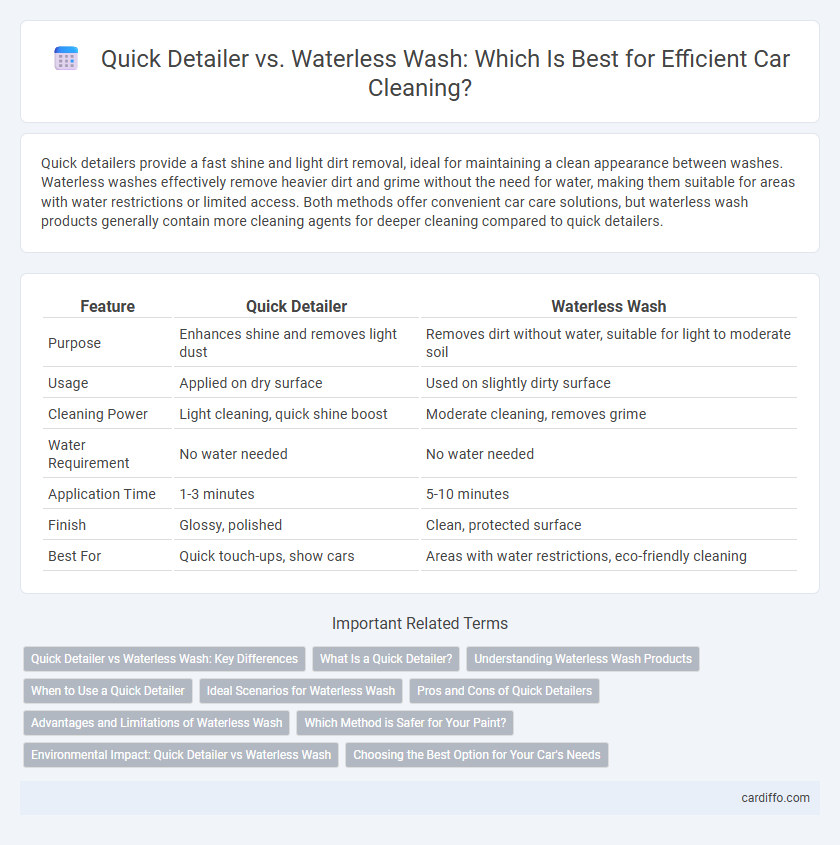Quick detailers provide a fast shine and light dirt removal, ideal for maintaining a clean appearance between washes. Waterless washes effectively remove heavier dirt and grime without the need for water, making them suitable for areas with water restrictions or limited access. Both methods offer convenient car care solutions, but waterless wash products generally contain more cleaning agents for deeper cleaning compared to quick detailers.
Table of Comparison
| Feature | Quick Detailer | Waterless Wash |
|---|---|---|
| Purpose | Enhances shine and removes light dust | Removes dirt without water, suitable for light to moderate soil |
| Usage | Applied on dry surface | Used on slightly dirty surface |
| Cleaning Power | Light cleaning, quick shine boost | Moderate cleaning, removes grime |
| Water Requirement | No water needed | No water needed |
| Application Time | 1-3 minutes | 5-10 minutes |
| Finish | Glossy, polished | Clean, protected surface |
| Best For | Quick touch-ups, show cars | Areas with water restrictions, eco-friendly cleaning |
Quick Detailer vs Waterless Wash: Key Differences
Quick Detailer and Waterless Wash differ primarily in their cleaning approach and residue levels; Quick Detailer is designed for light dust and fingerprints, providing a shiny finish with minimal effort, while Waterless Wash targets moderate dirt and grime, using lubricants to safely lift contaminants without water. Quick Detailers typically require less product per application, making them ideal for rapid touch-ups, whereas Waterless Wash solutions involve more thorough cleaning agents that prevent scratching during dirt removal. The choice depends on the vehicle's condition and cleaning frequency, with Quick Detailers excelling in enhancing appearance and Waterless Washes serving as efficient alternatives to traditional washing.
What Is a Quick Detailer?
A quick detailer is a spray-on cleaning product designed to remove light dirt, dust, and fingerprints from a vehicle's surface without the need for water or a full wash. It typically contains lubricants and polymers that help lift contaminants while enhancing the paint's gloss and providing a protective layer. Quick detailers are ideal for maintaining a clean, shiny finish between regular washes by offering fast, convenient cleaning and surface lubrication.
Understanding Waterless Wash Products
Waterless wash products combine advanced cleaning agents and lubricants to safely lift dirt and grime without water usage. These formulations typically include surfactants, polymers, and gloss enhancers designed to minimize surface abrasion while providing a polished finish. Understanding the ingredients and application techniques helps optimize results and protect automotive paint during maintenance cleanings.
When to Use a Quick Detailer
Quick Detailers are ideal for lightly soiled vehicles that need a fast touch-up between full washes, helping maintain shine and remove dust without water. Use a Quick Detailer when the surface is dry and free of heavy dirt or grime to avoid scratching the paint. This product is perfect for enhancing gloss and removing fingerprints or bird droppings quickly.
Ideal Scenarios for Waterless Wash
Waterless wash is ideal for light dirt and dust on vehicles stored indoors or parked for short periods, offering a quick, eco-friendly solution without the need for a hose. It prevents scratching and water spots, making it suitable for routine maintenance between full washes. Perfect for urban environments or areas with water restrictions, waterless wash preserves vehicle finish while saving time and resources.
Pros and Cons of Quick Detailers
Quick Detailers provide a fast and effective way to remove light dirt and enhance shine without water, making them ideal for spot cleaning and maintaining vehicle gloss between washes. They are user-friendly and minimize water usage, but they may struggle to remove heavier grime or stubborn contaminants compared to waterless wash solutions. Frequent use of quick detailers without prior washing can lead to surface scratches if abrasive particles are not fully removed.
Advantages and Limitations of Waterless Wash
Waterless wash offers the advantage of conserving water, making it an eco-friendly option for cleaning vehicles in areas with water restrictions. It effectively removes light dirt and dust without the need for rinsing, reducing time and effort compared to traditional washing methods. However, waterless wash has limitations with heavy grime or mud buildup, which may require pre-treatment or conventional washing to avoid scratching the surface.
Which Method is Safer for Your Paint?
Quick Detailer sprays contain lubricants and polymers that create a smooth surface, reducing the risk of scratches during light cleaning, making them safer for paint protection. Waterless wash products combine cleansing agents and lubricants to dissolve dirt while minimizing abrasion, but improper use or heavily soiled surfaces can still cause paint damage. For optimal paint safety, quick detailers are preferred for removing light dust, while waterless wash is better suited for moderate dirt when followed by careful technique.
Environmental Impact: Quick Detailer vs Waterless Wash
Quick Detailers typically contain synthetic chemicals that can leave residues harmful to aquatic ecosystems when rinsed off, whereas Waterless Wash products often use biodegradable and plant-based formulas designed to minimize environmental harm. Waterless Wash reduces water consumption drastically, conserving an average of 10 to 15 gallons per wash compared to traditional rinsing, thus lowering overall water waste and pollution. Selecting a certified eco-friendly Waterless Wash helps reduce the carbon footprint and protects freshwater resources more effectively than conventional Quick Detailers.
Choosing the Best Option for Your Car's Needs
Quick detailers provide a fast, easy way to enhance shine and remove light dust without water, making them ideal for maintaining a freshly washed vehicle. Waterless washes offer a more thorough clean using minimal moisture and special detergents, suitable for cars with moderate dirt and environmental restrictions on water usage. Selecting the best option depends on your car's current condition, frequency of cleaning, and local water regulations.
Quick Detailer vs Waterless Wash Infographic

 cardiffo.com
cardiffo.com